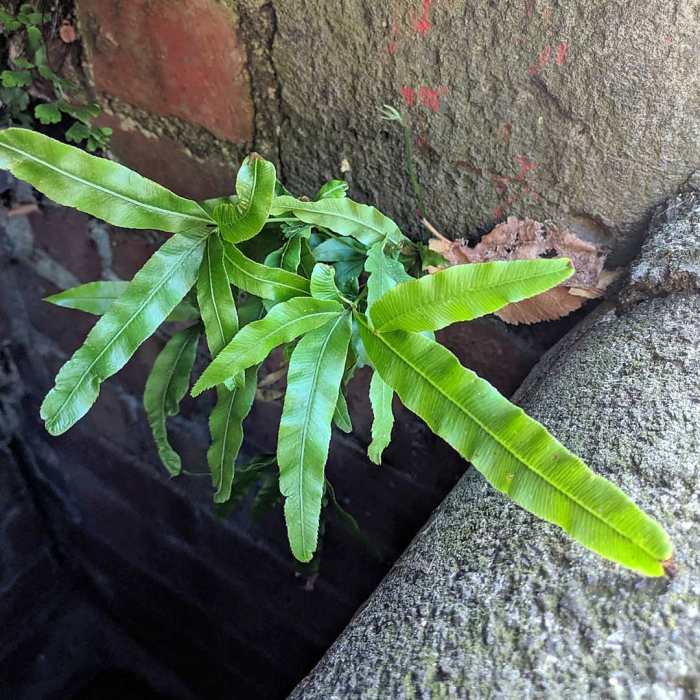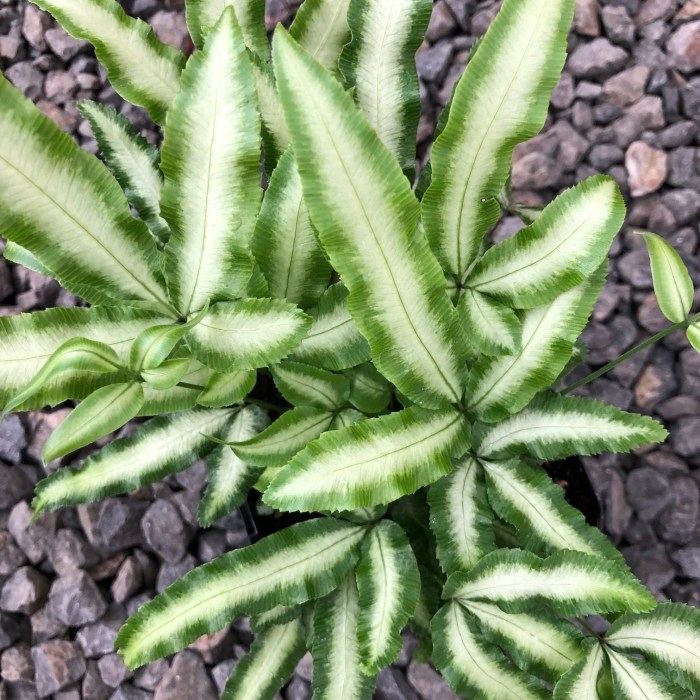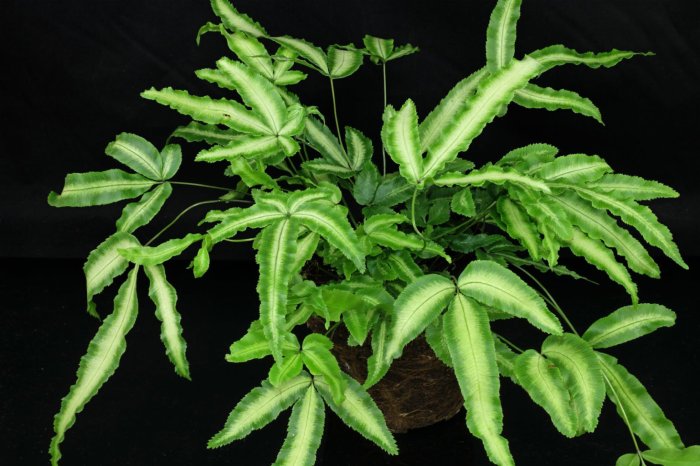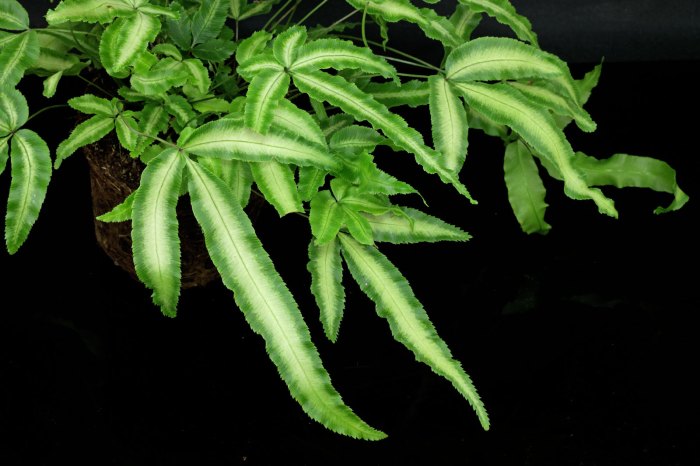The ribbon fern, with its graceful foliage and resilience, has captivated plant enthusiasts for centuries. This exquisite fern, known for its adaptability and striking appearance, invites us to explore its fascinating world of taxonomy, habitat, cultivation, uses, and conservation.
From its intricate fronds to its diverse applications, the ribbon fern unveils a captivating tale of nature’s wonders, offering insights into the delicate balance of our ecosystems.
Cultivation and Care of Ribbon Ferns

Ribbon ferns are relatively easy to cultivate and care for as ornamental plants, making them a popular choice for both indoor and outdoor gardens. However, they do have specific requirements for soil preparation, watering, fertilization, and pest control to ensure optimal growth and appearance.
Ribbon ferns, with their delicate fronds, are a popular choice for indoor plant enthusiasts. While they prefer bright, indirect light, they can tolerate low-light conditions. In fact, some species of ribbon ferns, such as the Asplenium nidus, are known for their ability to thrive in shady areas.
However, it’s important to note that most plants, including ribbon ferns, still require some sunlight for photosynthesis. If you’re considering adding a spider plant to your indoor plant collection, you may wonder if it has similar light requirements. To learn more about the light needs of spider plants, visit our article Do Spider Plants Need Sunlight? . Returning to the topic of ribbon ferns, their adaptability to low-light conditions makes them a versatile choice for various indoor environments.
Soil Preparation
Ribbon ferns prefer well-drained, acidic soil with a pH between 5.0 and 6.5. The soil should be rich in organic matter, such as peat moss or compost, to provide nutrients and moisture retention. A mixture of equal parts peat moss, perlite, and vermiculite is ideal for container-grown ferns.
Watering
Ribbon ferns require regular watering, especially during the growing season. The soil should be kept consistently moist but not waterlogged. Allow the top inch of soil to dry out slightly before watering again. During the winter months, reduce watering frequency to once or twice a month.
Fertilization
Fertilize ribbon ferns monthly during the growing season with a balanced liquid fertilizer diluted to half strength. Avoid over-fertilizing, as this can lead to nutrient burn.
Pest Control
Ribbon ferns are susceptible to a few common pests, including aphids, mealybugs, and spider mites. These pests can be controlled with insecticidal soap or neem oil.
Ribbon fern, a popular indoor plant, is known for its attractive foliage. However, like many plants, it can develop brown spots on its leaves. For guidance on treating brown spots on plants, including ribbon ferns, refer to this comprehensive guide: how to treat brown spots on plants . Early detection and proper treatment can help preserve the health and beauty of your ribbon fern.
Common Challenges
One common challenge associated with growing ribbon ferns is yellowing leaves. This can be caused by a variety of factors, including overwatering, underwatering, nutrient deficiency, or pest infestation. Another challenge is brown tips on the leaves, which can be caused by low humidity or excessive sunlight.By
following these cultivation and care guidelines, you can enjoy healthy and beautiful ribbon ferns in your home or garden.
4. Uses and Applications

Ribbon ferns have a rich history of traditional and modern uses in various cultures. Their versatility extends from medicinal applications to decorative purposes, making them a valuable plant in many settings.
Traditional Uses, Ribbon fern
Indigenous cultures have traditionally employed ribbon ferns for medicinal purposes. The Maori people of New Zealand used the plant to treat wounds, burns, and skin infections. In traditional Chinese medicine, ribbon ferns were believed to have cooling and diuretic properties, and were used to alleviate fever and promote urination.
Medicinal Properties
Modern research has identified several medicinal compounds present in ribbon ferns. Studies have shown that extracts from the plant possess antibacterial, antifungal, and antiviral activities. Additionally, ribbon ferns contain antioxidants that may help protect against cellular damage and reduce the risk of chronic diseases.
Landscaping and Decorative Applications
Ribbon ferns are popular in landscaping and gardening due to their graceful foliage and adaptability to various environments. Their delicate fronds add a touch of elegance to gardens, and they can be used as groundcovers, border plants, or in hanging baskets.
Ribbon ferns, known for their delicate foliage, require specific care to thrive indoors. While not as demanding as other popular houseplants like elephant plants , ribbon ferns benefit from regular misting, bright indirect light, and well-draining soil. By following these simple guidelines, you can ensure your ribbon fern flourishes and adds a touch of greenery to your home.
Ribbon ferns are also commonly used in terrariums and indoor plant displays, where their compact size and low light requirements make them ideal choices.
5. Conservation and Threats

Ribbon ferns, despite their beauty and ecological importance, face potential threats to their populations. Understanding their conservation status and implementing appropriate measures are crucial to ensure their survival.
Conservation Status
Ribbon ferns are not currently listed as endangered or threatened species globally. However, some populations may face local declines due to habitat loss, fragmentation, and other factors.
Ecological Importance
Ribbon ferns play a vital role in the ecosystem, contributing to biodiversity and providing habitat for various organisms. Their ability to thrive in diverse habitats makes them essential components of both terrestrial and aquatic ecosystems.
Threats
- Habitat loss and degradation:Urbanization, agriculture, and other land use changes can lead to the destruction or fragmentation of ribbon fern habitats.
- Pollution:Runoff from agricultural areas and industrial effluents can introduce contaminants into water bodies, harming ribbon ferns and other aquatic organisms.
- Invasive species:Invasive plants can outcompete ribbon ferns for resources, reducing their populations and altering ecosystem dynamics.
- Climate change:Changes in temperature, precipitation patterns, and sea levels can impact ribbon fern habitats and their ability to thrive.
Conservation Measures
To protect ribbon ferns and ensure their survival, various conservation measures can be implemented:
- Habitat protection:Identifying and protecting critical ribbon fern habitats through conservation easements or land acquisition.
- Restoration and enhancement:Restoring degraded habitats and enhancing existing ones to support ribbon fern populations.
- Pollution control:Implementing regulations and best management practices to reduce pollution runoff into water bodies.
- Climate change adaptation:Developing strategies to mitigate the impacts of climate change on ribbon fern habitats and populations.
li> Invasive species management:Controlling the spread of invasive plants through targeted removal or management techniques.
Final Wrap-Up

As we delve deeper into the world of ribbon ferns, we uncover a tapestry of beauty, resilience, and ecological significance. Their delicate fronds not only adorn our gardens but also serve as a testament to the intricate web of life that sustains our planet.
By understanding and cherishing these remarkable plants, we can contribute to their preservation and ensure their continued grace in our world.
Expert Answers
How can I grow ribbon ferns in my home?
Ribbon ferns prefer bright, indirect light, well-draining soil, and consistent moisture. They can be grown in pots or hanging baskets.
What are the medicinal properties of ribbon ferns?
Ribbon ferns have traditionally been used to treat wounds, burns, and skin infections. They contain compounds with anti-inflammatory and antimicrobial properties.
Are ribbon ferns rare?
Ribbon ferns are relatively common in their native habitats, but some species can be threatened by habitat loss and over-collection.